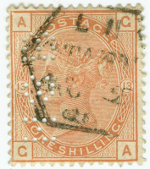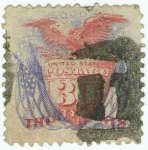
Discussion - Member to Member Sales - Research Center

Discussion - Member to Member Sales - Research Center


Each of the three stamps is presented as a single column. The bottom row is the stamp immersed in watermark fluid.
The stamp on the left (#4, on "wove paper"), and the one in the center (#4c, on "ribbed paper") are in my collection. The stamp on the right is the one in question.
Here's what I see and understand. There are no differences in the stamp on the right and the stamp on the left. Laid paper has ribs (horizontal for this issue), but they are closer together than "ribbed" paper. Also, laid paper did not absorb printing ink as well as wove paper, so the stamp image is not as well transferred on laid paper.
I'm inclined to think that the stamp on the right, represented as #1 on laid paper is, instead #4, on wove paper. I really see no differences at all between the stamp on the right and the stamp on the left.
What do you think?
Thanks,
-Paul

Login to Like
this post
An update.
Still trying to learn how to identify "laid" paper. Should have "laid lines" either horizontally or vertically. Here is a description from wikipedia:
"Laid paper is a type of paper having a ribbed texture imparted by the manufacturing process. In the pre-mechanical period of European papermaking (from the 12th century into the 19th century), laid paper was the predominant kind of paper produced. Its use, however, diminished in the 19th century, when it was largely supplanted by wove paper. Laid paper is still commonly used by artists as a support for charcoal drawings.
Before the mechanization of papermaking, paper was made by hand, using a wire sieve mounted in a rectangular mold to produce a single sheet at a time. A papermaker would dip the mold into a vat containing diluted pulp of hemp or linen fibers, then lift it out, tilt it to spread the pulp evenly over the sieve and, as the water drained out between the wires, shake the mold to lock the fibers together. In the process, the pattern of the wires in the sieve was imparted to the sheet of paper.
Up until the invention of wove paper around 1756, these screens were made up of thicker, more widely spaced wires around which were woven finer and more tightly packed wires. The traditional laid pattern thus consists of a series of wide-spaced lines (chain lines) parallel to the shorter sides of the sheet and more narrowly spaced lines (laid lines) at right angles to the chain lines."
Here are a few exemplary images:
Scott #33:

Scott #210E:

The horizontal laid lines are most prominent to the right of the central vignette, and in the right margin.
a Grenada essay:

The large selvedge at the bottom gives you a good look at the horizontal laid lines.
Finally, here's a Latvia block with vertical laid lines:

-Paul
PS, let me throw up this interesting block of CSA #11, on laid paper:


Login to Like
this post
Hi, if you look your third stamp, immersed in watermark fluid, you see larges horizontal lines, mainly in the top half (similar to the "33" on your post). It should be a #1, but at this value, you must send it for expertised ...
sorry for my limited english, Jacques

Login to Like
this post
Ah, but for the Canada beaver, there is a woven RIBBED paper (Scott #4c). I have not seen Scott #1 (laid paper) next to Scott #4c ribbed woven paper, but here's an interesting proxy, Scott #2, which is shown only on laid paper:

This one is expertized as Canada #2.
Frankly, I don't see the laid lines. Must be really tough to distinguish them for these 1851 Canada issues!
-Paul
PS, Jacques, you may be right! I owned that stamp for a short period, but returned it for a refund.

Login to Like
this post
I could be wrong, but on this scan (#2), we see vertical lines mainly in the middle... (I think)
Jacques

Login to Like
this post
Very perceptive Jacques!
I did find one certificate for this issue (Scott #2) that mentioned VERTICAL laid lines.
And then, we have this:

"without visible laid lines"
What's a poor collector to do?!?!?
I realize that the laid paper did not take ink up as well as wove paper, so I suppose that, if one looked at enough of these stamps, one could distinguish the two papers on that account alone. That will probably never be me. Hence, expertizers.
-Paul

Login to Like
this post
02:26:52pm
I've recently been offered what is represented as Canada #1, the 3c Beaver on laid paper. I have two other Beavers to compare it to. I'm presenting these 3 stamps to the collective wisdom of SOR for their judgement. As a caveat, I spent some time looking at various resources for distinguishing laid paper from wove paper, not to my greatest satisfaction.

Each of the three stamps is presented as a single column. The bottom row is the stamp immersed in watermark fluid.
The stamp on the left (#4, on "wove paper"), and the one in the center (#4c, on "ribbed paper") are in my collection. The stamp on the right is the one in question.
Here's what I see and understand. There are no differences in the stamp on the right and the stamp on the left. Laid paper has ribs (horizontal for this issue), but they are closer together than "ribbed" paper. Also, laid paper did not absorb printing ink as well as wove paper, so the stamp image is not as well transferred on laid paper.
I'm inclined to think that the stamp on the right, represented as #1 on laid paper is, instead #4, on wove paper. I really see no differences at all between the stamp on the right and the stamp on the left.
What do you think?
Thanks,
-Paul

Login to Like
this post
10:47:36am
re: for the Canada pence collectors
An update.
Still trying to learn how to identify "laid" paper. Should have "laid lines" either horizontally or vertically. Here is a description from wikipedia:
"Laid paper is a type of paper having a ribbed texture imparted by the manufacturing process. In the pre-mechanical period of European papermaking (from the 12th century into the 19th century), laid paper was the predominant kind of paper produced. Its use, however, diminished in the 19th century, when it was largely supplanted by wove paper. Laid paper is still commonly used by artists as a support for charcoal drawings.
Before the mechanization of papermaking, paper was made by hand, using a wire sieve mounted in a rectangular mold to produce a single sheet at a time. A papermaker would dip the mold into a vat containing diluted pulp of hemp or linen fibers, then lift it out, tilt it to spread the pulp evenly over the sieve and, as the water drained out between the wires, shake the mold to lock the fibers together. In the process, the pattern of the wires in the sieve was imparted to the sheet of paper.
Up until the invention of wove paper around 1756, these screens were made up of thicker, more widely spaced wires around which were woven finer and more tightly packed wires. The traditional laid pattern thus consists of a series of wide-spaced lines (chain lines) parallel to the shorter sides of the sheet and more narrowly spaced lines (laid lines) at right angles to the chain lines."
Here are a few exemplary images:
Scott #33:

Scott #210E:

The horizontal laid lines are most prominent to the right of the central vignette, and in the right margin.
a Grenada essay:

The large selvedge at the bottom gives you a good look at the horizontal laid lines.
Finally, here's a Latvia block with vertical laid lines:

-Paul
PS, let me throw up this interesting block of CSA #11, on laid paper:


Login to Like
this post

re: for the Canada pence collectors
Hi, if you look your third stamp, immersed in watermark fluid, you see larges horizontal lines, mainly in the top half (similar to the "33" on your post). It should be a #1, but at this value, you must send it for expertised ...
sorry for my limited english, Jacques

Login to Like
this post
11:27:10am
re: for the Canada pence collectors
Ah, but for the Canada beaver, there is a woven RIBBED paper (Scott #4c). I have not seen Scott #1 (laid paper) next to Scott #4c ribbed woven paper, but here's an interesting proxy, Scott #2, which is shown only on laid paper:

This one is expertized as Canada #2.
Frankly, I don't see the laid lines. Must be really tough to distinguish them for these 1851 Canada issues!
-Paul
PS, Jacques, you may be right! I owned that stamp for a short period, but returned it for a refund.

Login to Like
this post

re: for the Canada pence collectors
I could be wrong, but on this scan (#2), we see vertical lines mainly in the middle... (I think)
Jacques

Login to Like
this post
11:48:59am
re: for the Canada pence collectors
Very perceptive Jacques!
I did find one certificate for this issue (Scott #2) that mentioned VERTICAL laid lines.
And then, we have this:

"without visible laid lines"
What's a poor collector to do?!?!?
I realize that the laid paper did not take ink up as well as wove paper, so I suppose that, if one looked at enough of these stamps, one could distinguish the two papers on that account alone. That will probably never be me. Hence, expertizers.
-Paul

Login to Like
this post

